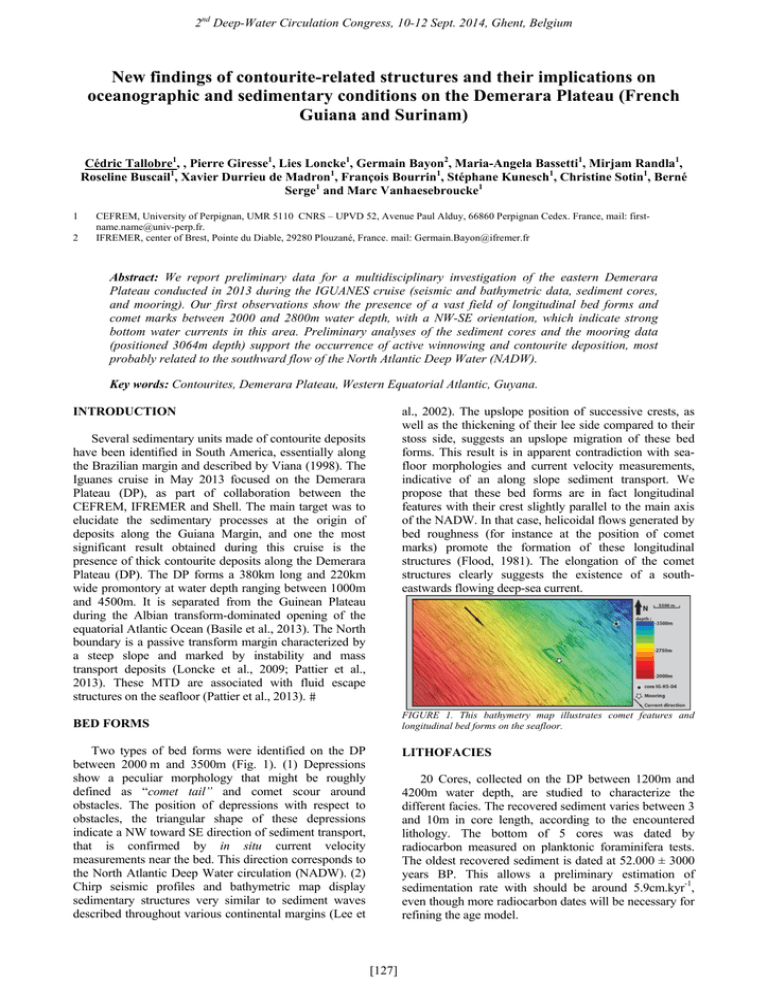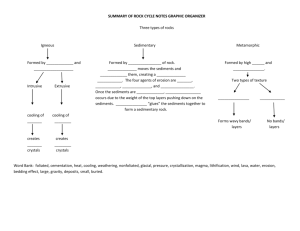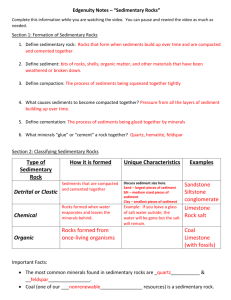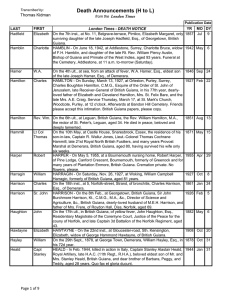New findings of contourite-related structures and their implications on
advertisement

2nd Deep-Water Circulation Congress, 10-12 Sept. 2014, Ghent, Belgium New findings of contourite-related structures and their implications on oceanographic and sedimentary conditions on the Demerara Plateau (French Guiana and Surinam) Cédric Tallobre1, , Pierre Giresse1, Lies Loncke1, Germain Bayon2, Maria-Angela Bassetti1, Mirjam Randla1, Roseline Buscail1, Xavier Durrieu de Madron1, François Bourrin1, Stéphane Kunesch1, Christine Sotin1, Berné Serge1 and Marc Vanhaesebroucke1 1 2 CEFREM, University of Perpignan, UMR 5110 CNRS – UPVD 52, Avenue Paul Alduy, 66860 Perpignan Cedex. France, mail: firstname.name@univ-perp.fr. IFREMER, center of Brest, Pointe du Diable, 29280 Plouzané, France. mail: Germain.Bayon@ifremer.fr Abstract: We report preliminary data for a multidisciplinary investigation of the eastern Demerara Plateau conducted in 2013 during the IGUANES cruise (seismic and bathymetric data, sediment cores, and mooring). Our first observations show the presence of a vast field of longitudinal bed forms and comet marks between 2000 and 2800m water depth, with a NW-SE orientation, which indicate strong bottom water currents in this area. Preliminary analyses of the sediment cores and the mooring data (positioned 3064m depth) support the occurrence of active winnowing and contourite deposition, most probably related to the southward flow of the North Atlantic Deep Water (NADW). Key words: Contourites, Demerara Plateau, Western Equatorial Atlantic, Guyana. al., 2002). The upslope position of successive crests, as well as the thickening of their lee side compared to their stoss side, suggests an upslope migration of these bed forms. This result is in apparent contradiction with seafloor morphologies and current velocity measurements, indicative of an along slope sediment transport. We propose that these bed forms are in fact longitudinal features with their crest slightly parallel to the main axis of the NADW. In that case, helicoidal flows generated by bed roughness (for instance at the position of comet marks) promote the formation of these longitudinal structures (Flood, 1981). The elongation of the comet structures clearly suggests the existence of a southeastwards flowing deep-sea current. INTRODUCTION Several sedimentary units made of contourite deposits have been identified in South America, essentially along the Brazilian margin and described by Viana (1998). The Iguanes cruise in May 2013 focused on the Demerara Plateau (DP), as part of collaboration between the CEFREM, IFREMER and Shell. The main target was to elucidate the sedimentary processes at the origin of deposits along the Guiana Margin, and one the most significant result obtained during this cruise is the presence of thick contourite deposits along the Demerara Plateau (DP). The DP forms a 380km long and 220km wide promontory at water depth ranging between 1000m and 4500m. It is separated from the Guinean Plateau during the Albian transform-dominated opening of the equatorial Atlantic Ocean (Basile et al., 2013). The North boundary is a passive transform margin characterized by a steep slope and marked by instability and mass transport deposits (Loncke et al., 2009; Pattier et al., 2013). These MTD are associated with fluid escape structures on the seafloor (Pattier et al., 2013). FIGURE 1. This bathymetry map illustrates comet features and longitudinal bed forms on the seafloor. BED FORMS Two types of bed forms were identified on the DP between 2000 m and 3500m (Fig. 1). (1) Depressions show a peculiar morphology that might be roughly defined as “comet tail” and comet scour around obstacles. The position of depressions with respect to obstacles, the triangular shape of these depressions indicate a NW toward SE direction of sediment transport, that is confirmed by in situ current velocity measurements near the bed. This direction corresponds to the North Atlantic Deep Water circulation (NADW). (2) Chirp seismic profiles and bathymetric map display sedimentary structures very similar to sediment waves described throughout various continental margins (Lee et LITHOFACIES 20 Cores, collected on the DP between 1200m and 4200m water depth, are studied to characterize the different facies. The recovered sediment varies between 3 and 10m in core length, according to the encountered lithology. The bottom of 5 cores was dated by radiocarbon measured on planktonic foraminifera tests. The oldest recovered sediment is dated at 52.000 ± 3000 years BP. This allows a preliminary estimation of sedimentation rate with should be around 5.9cm.kyr-1, even though more radiocarbon dates will be necessary for refining the age model. [127] 2nd Deep-Water Circulation Congress, 10-12 Sept. 2014, Ghent, Belgium December 2013. The current is connected to the NADW located between 1200m and 4000m (Viana, 1998). CONCLUSION We present recently acquired data (i.e. comet structures, longitudinal bed forms, winnowing illustrated by glauconite concentration and sand beds, and current meter measurements) which indicate the presence of contourites along the DP. The presence of contourites around this Plateau could be promoted by the morphology and by the steep slope related to the transform margin. Future work should aim to better understand the links between contourites and slope instability on the DP. ACKNOWLEDGEMENTS The authors would like to thank the Iguanes scientific team and the crew of the N/O Atalante. We also thank Shell Company for supporting Cedric Tallobre’s PhD Project. FIGURE 2. Sedimentary log of IG-KS-04 section 1: This section illustrates the lithology variations between sand and mud intervals. On the whole, main lithological facies can be synthesized as follow: on the top, a layer of variable thickness made of brownish sediments, rich in planktonic foraminifera (Fig. 2). Below, the sediments are made of grey/greenish clays mottled by bioturbations and by glauconite-rich greenish lenses and beds (Fig. 2). These sediments contain sparse bioclasts in the silty matrix: foraminifera, pteropods, others gastropods, urchins, sponges. Occasionally, coarse-grained sands beds rich in foraminifera and glauconite are found. Shells and tests found in these levels are very fragmented. Glauconite is thought to be formed in situ by clays minerals transformation at the sea-sediment interface (Giresse, 2008). The maturity of glauconitic grains is related with the residence time of sediments along this interface and also the rate of sedimentation (Giresse, 2008). The winnowing caused by a bottom current can slow down or prevent the accumulation of fine sediments and then can promote the formation and the maturation of glauconite. The winnowing is linked to high energy hydrodynamic conditions which prevents the deposit of fine-grained particles and promotes the coarser deposit setting. The variation of the bottom current velocity controls the construction of more or less sandy sequences as illustrated in the Fig. 2 (Gonthier et al., 1984). Sedimentary structures are poorly preserved, probably because of the strong bioturbation. Evidence of MTD including massive debrites is found in some of the collected cores. These are blocks composed by white indurated sediments rich in planktonic foraminifera. They are systematically observed under the comet scours observed on the seafloor suggesting that they form hard reliefs that boost the development of those structures. On the sea floor, some comet structures may initiate along pockmarks as stated by Pattier et al., 2013. REFERENCES Basile C., Maillard A., Patriat M., Gaullier V., Loncke L., Roest W., Mercier de Lépinay M. et Pattier F. (2013). Structure and evolution of the Demerara Plateau, offshore French Guiana: Rifting, tectonic inversion and post-rift tilting at transform–divergent margins intersection. Tectonophysics 591, pp. 16-29. Flood, R.D. (1981). Distribution, morphology, and origin of sedimentary furrows in cohesive sediments, Southampton Water. Sedimentology 28, 511–529. Gonthier E., Faugères J.C. et Stow D.A.V. (1984). Contourite facies of the Faro drift, Gulf of Cadiz. In: "Fine grained sediments: deep water processes and facies". Geol. Soc. of London, Special Publ., p. 275292. Giresse P. (2008). Some aspects of diagenesis in contourites, in: M. Rebesco and A. Camerlenghi, Contourites, elsevier pub., developments in sedimentology 60, pp. 203-221. Lee, H.J., Syvitski, J.P.M., Parker, G., Orange, D., Locat, J., Hutton, E. W.H., Imran, J. (2002). Distinguishing sediment waves from slope failure deposits: field examples, including the ‘Humboldt Slide’, & modelling results. Mar. Geol. 192, 79-104. Loncke L., Droz L., Gaullier V., Basile C., Patriat M. et Roest W. (2009). Slope instabilities from echocharacter mapping along the French Guiana transform margin and Demerara abyssal plain. Marine and petroleum Geology, 26, pp: 711-723. Pattier, F., Loncke L., Gaullier V., Basile B., Maillard A., Imbert P., Roest W.R., Vendeville B.C., Patriat M., Loubrieu B. (2013a). Mass-transport deposits and fluid venting in a transform margin setting, the eastern Demerara Plateau (French Guiana). Mar. and Pet. Geol. 46, pp. 287-303. Viana A.R. (1998). Le rôle et l’enregistrement des courants océaniques dans les dépôts de marges continentales: la marge du bassin Sud-Est Brésilien. Thesis, University of Bordeaux I. OCEANOGRAPHY According to the measurements acquired on the sea bottom over a year time-laps, the comet-area is the place of a SE oriented current. Its mean velocity is 9.5cm.s-1 with some peaks reaching 32.5cm.s-1 recorded in [128]








